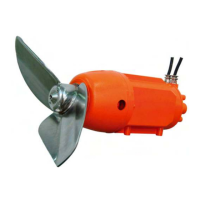Use and Maintenance instructions
Submersible horizontal mixers
“ TBM “ series
Release 03 / 2014
15
8. ELECTRICAL CONNECTIONS
8.1. Connection of electrical motor to control panel
DANGER!
The voltage-carrying and rotating parts of electric machines can cause severe or fatal injuries.
Installation, connection, commissioning as well as servicing and repair work may only be carried out by
qualified technicians with due regard for:
− these instructions
− all other project documentation relating to the drive, commissioning instructions and electrical
− all currently valid national and local regulations relating to safety and accident prevention
As a principle all electrical connections must be carried out by a qualified electrician.
All electrical connection necessary to operate the mixer are responsibility of the installer, who also has the
responsibility to ensure that the control panel is in accordance with National rules, and that it has an
adequate degree of protection with respect to installation area. Install electrical equipment in dry area.
Otherwise make use of special equipment.
Electrical motor characteristics are indicated on data plate.
The mixer is supplied complete of connection to mains. The core code numbers are indicated along the
corresponding cores (s. connection diagram in 8.3.4).
Before connecting the motor, the actual operating voltage must be compared with the voltage data on the
motor specification plate and with the motor windings. Please refer to Fig. 8.3.
WARNING After ensuring the electric connection, ensure that the direction of rotation is correct: watching
the mixer from the back side of the motor, the propeller must rotate clockwise. In order to reverse the
direction of rotation, exchange two phases.
Three phases conductor (L1, L2, L3) must not be confused with neutral conductor (N) or earth conductor
(yellow-green).
Do not change the position of cables coming from the electrical motor to the terminal board (U1, V1, W1, or
U2, V2, W2) to avoid errors in Y-∆ starting system.
WARNING Undersized or poor-quality electrical equipment may undergo rapid contact deterioration and
consequently power the motor incorrectly, which may damage the equipment. In order to ensure safe
operation, install good-quality electrical equipment.
WARNING The use of inverters or soft-starters, if not correctly planned and implemented, could damage
the mixer, not only in its electrical components but also the mechanical elements.
If the associated problems are not fully understood, request assistance from the Cri-
Technical Offices.
Operation with Inverters or Soft-starters:
The structure and motor insulation used are suitable for use with Inverters and Soft-starters but some
essential operating conditions must be satisfied:
- Comply with the electromagnetic compatibility directives.
- The lower threshold frequency must be regulated so that the machine does not operate below 30 Hz.
- The upper frequency threshold must be regulated so that the nominal motor power is not exceeded
(max frequency 50 Hz).
The most recent inverters operate at high repetition frequencies and with sharp increases in voltage ramp.
This reduces power losses and motor noise but generates sharp voltage peaks in the motor coil. These
voltage peaks negatively influence the duration of transmission, relative to the operating voltage and the
cable length between the motor and inverter. The voltage ramp dU / dt, typical of a PWM inverters, must be
lower than 1 kV / µs. In general this value does not affect traditional asynchronous motors, like those used in
the TBM series mixers, if the cable has a length less than 40 to 50m. In any case it is good practice to fit at
least three sinusoidal filters between the motor and inverter and if the cable is longer than stipulated above
other types of filters are required.

